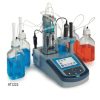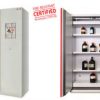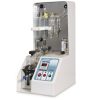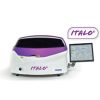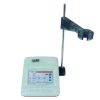Sulfur dioxide gas gives off a pungent, acrid aroma reminiscent of a burnt match.
It is not possible to make wine without SO2 because all yeasts during fermentation produce sulphites as a metabolic intermediate in the reduction of sulphates.
Yeast strains can be classified into low SO2 producers (e.g. Saccharomyces cerevisiae var. ellipsoideus) and high producers (e.g. Saccharomyces bayanus Sacardo).
The consumer is increasingly sensitive to the issues of sustainability and green production; a trend recorded by a strong growth in the consumption of “Bio” products.
Numerous alternatives to the use of sulfur dioxide in musts and wines are currently being studied; however, it remains the most representative preservative for the wine sector.
Sulphur dioxide has several properties of oenological interest:
- It is an antimicrobial: it helps prevent the development of bacterial microbes and inhibits unselected yeasts
- It is an antioxidant due to its ability to inhibit enzymatic browning
- It is an antioxidant due to its ability to reduce chemical oxidations of phenolic substances.
- helps prevent aromas and color during storage to preserve the qualities and characteristics of the wine.
- promotes turbidity by facilitating the separation of suspended fecal substances.
It is used during all stages of production, from harvest to refinement.
It is important to calculate the right dose at the right time, to carry out the desired task without excess and without compromising the quality of the wine
Sulfur dioxide is present in wine in various forms
SO2 FREE
Free sulfur dioxide is present as Molecular – Sulfurous Acid H2SO3 (undissociated fraction), Bisulfite Ion HSO3 – (semi-dissociated fraction) and as Sulfite Ion SO3–(totally dissociated fraction).
The formula that binds SO2 is:

The power of Free SO2 is:
- Antioxidant and Antioxidase in Bisulfite Ion and Molecular Form
- Antiseptic in its molecular form
As you can see from the graph below, at the pH value of wine, the Sulphite Ion form SO3 is in very small quantities

From the first formula, it can be noted that the balance between the Bisulphite Ion and the molecular SO2 depends on the H+ ion, therefore on the pH, in addition to the temperature, and on the alcohol concentration.
The Bisulphite Ion is the most present linked to acetaldehyde, glucose, quinones, anthocyanins and ketoacids.
Its balance depends on the pH, the Temperature and the Alcohol concentration
Its value decreases with the passage of time, therefore it is necessary to determine it often
The balance between the Labile Combined SO2 and the Free SO2 depends solely on the temperature, in fact an increase in temperature can transform Combined SO2 into Free SO2.
MOLECULAR SO2
It represents the undissociated form (H2SO3 Sulphurous Acid) and has a characteristic odour and taste.
It is extremely important to know its concentration as it is the only form that plays an antiseptic role in the microbiological stabilization of wine, thanks to its bacterial and fungicidal activity.
Small variations in Molecular SO2 cause significant effects on the must/wine environment
The pKa value (Acid strength) is influenced by various parameters such as temperature, alcohol content and ionic strength, i.e. the concentration of salts (wine ion and cation .. Sulphate Ions, Carbonate Ion, K + Potassium Cation, Ca ++ Cation, Magnesium ++ Cation, Sodium Ca ++ Cation)
The temperature that favors the absorption of molecular SO2 by cells has its maximum influence at 50 °C.

How is Molecular SO2 determined?
To determine Molecular SO2 it is necessary to know the exact measurement of Free SO2
Table to relate the value to 20°
Knowing the pH and the Alcohol content, it is possible to determine the concentration of Molecular SO2 from the Michelet table. It can be seen that the concentration increases with decreasing pH and increasing Alcohol.
Table to determine the value of Molecular SO2 at storage temperature

SO2 COMBINATED
Combined sulfur dioxide is present bound in a more or less stable manner with compounds such as acetaldehyde, sugars, keto acids, uronic acids, sugar oxidation products and anthocyanins.
Depending on the stability of the bond, a further distinction is made between:
Labile Combined, i.e. weak bonds that can dissociate upon heating, giving rise to free SO2.
Stable Combination i.e. strongly bound to acetaldehyde.

This bond can be broken during oxidation with the release of acetaldehyde.
TOTAL SO2
Total SO2 is given by the sum of all forms of SO2 present in the wine:
H2SO3 Molecular +
HSO3- Bisulfite Ion +
SO3– Sulfite Ion +
Labile Combination +
Stable Combined =
Total SO2
SO2 ANALYTICAL DETERMINATION
There are various analysis systems for determining SO2 in wines, musts and their derivatives, all regulated by the O.I.V INTERNATIONAL ORGANISATION OF VINE AND WINE (International Organisation of
Vineyard and Wine)
METHOD RIPPER – SCHMITT
OIV-MA-AS323-04B
The determination of sulfur dioxide by the Ripper – Schrnitt method is based on the oxidation of sulphites with iodine in the presence of the indicator “starch solution”.
OSSIDAZIONE: SO2→ SO3+ 2e –
(nell’ossidazione perde 2 elettroni)
REDUCTION: I2 + 2e-→ 2 I –
(the I2 molecule accepts 2 electrons to be reduced)
Overall redox reaction:
SO2 + I2 + H2O ———> SO3 + 2 HI
SO3 + H2O ——-> H2SO4
When all the SO2 has been oxidized to SO3, the I2 finds no SO2 to oxidize and turns blue-violet in the presence of starch solution. To determine the total SO2, it is necessary to release the combined SO2 by performing an alkaline hydrolysis so that it becomes oxidizable directly by the I2 in an acidic environment.
The environment must be very acidic (pH < 1) otherwise the I2 could also oxidize the polyphenols.
If the sample has high copper values, it is complexed with a few mg of EDTA, excluding it from the reaction.

The addition of Sulfuric Acid releases much of the SO2 combined with Anthocyanins
In Red wines, a polarized yellow light lamp is normally used to identify the end point of titration.

FM10 Lamp
If Ascorbic Acid has been added, the result is influenced by its concentration because it is oxidizable by Iodine
To determine it, proceed as follows:
° take 50ml of sample
° add 5ml of Propionic Aldehyde or Acetic Aldehyde to inhibit SO2.
° perform the analysis of the Free SO2 of the sample
° the value obtained represents the concentration of Ascorbic Acid.
 To reduce time, eliminate human error and automate the analysis process, Automatic
To reduce time, eliminate human error and automate the analysis process, Automatic
Titrators are used.
Find more information on the page:
https://www.exactalabcenter.it/enologia/titolatorihach-lange-serie-at1000
The titrator automates the Ripper Schmitt method
The reaction reagents are dosed through peristaltic pumps.
Pump 1 H2SO4 Sulfuric Acid
Pump 2 NaOH Sodium Hydrate
Iodine is dosed automatically through the 10,000 ml syringe controlled by a 24,000 step motor
The titration occurs completely automatically thanks to a Platinum-Platinum electrode to which a micro polarization current is applied



